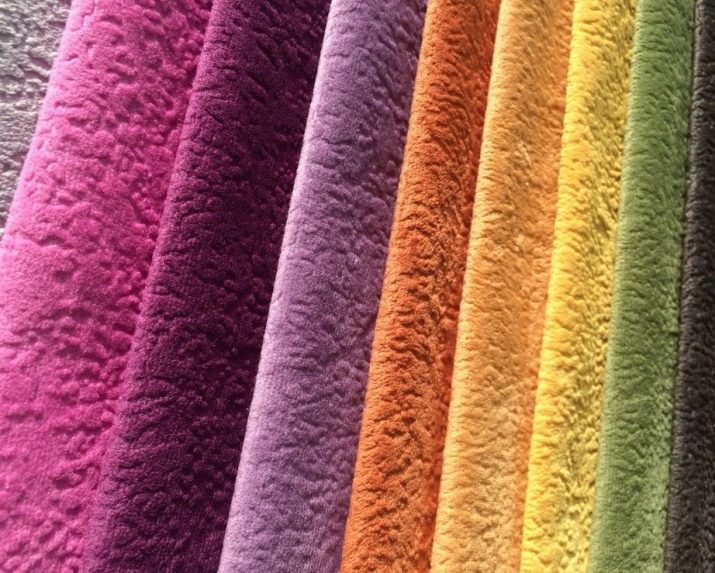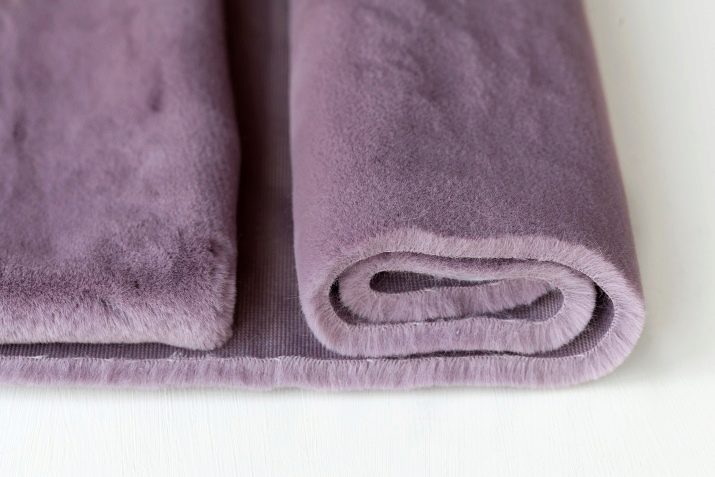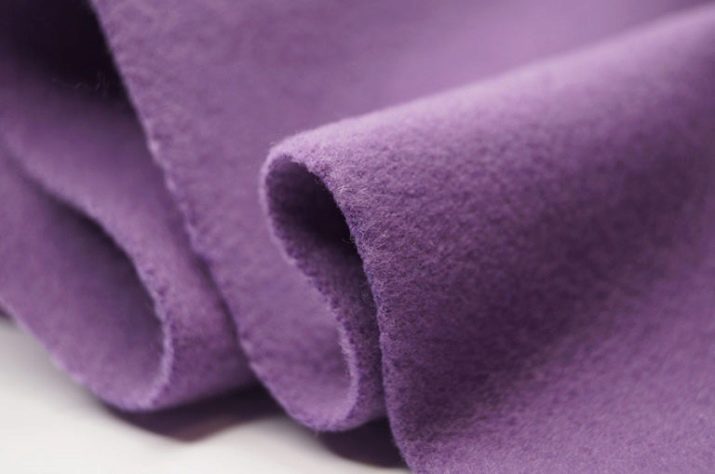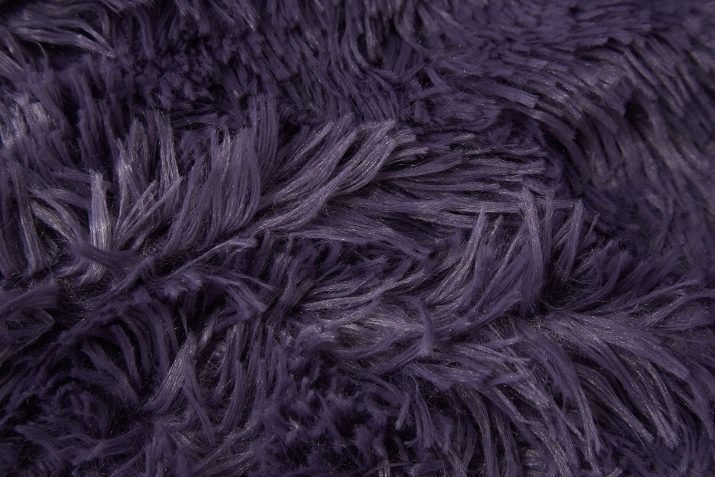What are the types of pile fabrics and where are they used?

Pile fabrics are presented in a separate group, which includes fabrics, united by common characteristics. Their surface is covered with villi of different lengths or densities.

Due to their charming appearance and other positive characteristics, such canvases are actively used in various fields.
general description
The fleecy fabric is lined only on the front side, it stays smooth on the inside... These textile products are pleasant to the touch, keep you warm and can transform any look. The most popular varieties are velvet, chenille, velor and alcantara. Also, modern buyers and manufacturers choose silk, wool and felt with nap of various lengths. Their surface is covered with whole or cut fibers. In addition, each type of fabric has its own characteristics for care and operation.

The pile can completely cover one of the sides of the material or be concentrated in only one or several areas.... In specialized stores you can find fabrics of different colors and shades, which increases the scope of their application.

Pile fabrics have the following general characteristics:
- high resistance to wear;
- effective noise absorption;
- reliable protection against draft and wind;
- fabric retains warmth, maintaining comfortable temperature conditions in cold weather;
- simple drapery;
- graceful and attractive appearance.

The huge assortment has become possible thanks to innovative developments. Special equipment allows to produce large volumes of products while maintaining high quality.

The colorants used by trade marks must be sufficiently bright and persistent. Otherwise, the fabric will lose its saturation after each wash.
Types of fabrics with pile
There are several main subspecies of these fabrics.
With thick
Fabrics with fluffy and thick pile have maximum wear resistance. Such canvases retain their commercial attractiveness for a long time even with intensive use.

Velveteen
Experienced craftswomen easily recognize this fabric by its special texture. On the front side, pile scars are noticeable, their width is up to 0.5 centimeters. Currently, in the manufacture of this type of material, viscose or polyamide (fabrics of artificial origin) is added to natural cotton. Also on sale you can find corduroy, which was completely made from synthetic raw materials. The special texture of the fabric is perfect for making warm and comfortable outerwear. Corduroy also found its application in the production of clothing and upholstered furniture.

Velvet
The dense, popular material features a short but dense pile. Velvet has gained its popularity due to its expressive radiance and charming play. The sophisticated appearance will not leave indifferent any fashionista. To enhance the decorative properties of the fabric, its surface is decorated with a pattern or embossing. The high quality material retains its shape and does not shrink, and the touch causes only positive emotions and pleasant sensations. Special skills are required to work with velvet, as it is difficult to process.

Drap velor
This type of material is made from natural woolen cloth. The fabric is thin, with dense and vertically arranged villi... During the production process, the pile is carefully trimmed to the desired length, and not pressed. The material is suitable not only for sewing clothes, but also for hats and other products. Velor drape curtains can be found in houses of culture, theaters and other similar institutions.

Note: Some items made with thick pile fabrics cannot be washed in a regular washing machine. To care for them, you will need to contact a dry cleaner.
With a long
Long-pile fabric is classified depending on the origin of the raw materials used and the manufacturing technique. As a result, canvases with both small and large, high pile are obtained.

Plush
For the manufacture of plush, natural raw materials are mainly chosen, it can be cotton or woolen fibers. It is permissible to add a small amount of artificial materials, which will increase its resistance to damage and wear resistance. The villi are lush, soft and long.
If the base of the plush is cotton, the villi will be shorter. Experts attribute the fabric to one of the varieties of velvet, but plush is a long-pile fabric. Due to its special texture, the material is ideal for sewing blankets, soft toys and other products.

Velours
The next type of fabric looks very similar to the velvet known to many, but differs in the length of the pile. Modern manufacturers use natural products (cotton and wool) and synthetics. The scope of application of velor directly depends on its composition. Artificial velor makes dense and comfortable car covers. The material gives a pleasant tactile sensation and easily retains heat.

Artificial fur
Recently, this material has been rapidly gaining popularity, which has been facilitated by an active eco-movement. It is an alternative to natural fur. This material can have a knitted base or it is produced on special weaving machines, choosing a two-sheet method... If the manufacturer uses the glue method, the pile is fixed to the base (ground) with a special adhesive.
Note: canvases from the latter category require special care and careful handling.A pile damaged by a stain will be very difficult to clean, sometimes almost impossible.
The lush surface collects and retains dust, so regular cleaning is required. In the presence of synthetic raw materials in the composition of the canvas will be electrified.

With soft
To keep the front surface soft and pleasant to the touch, these types of canvases must be handled with care. Not only their appearance depends on this, but also the stability of their shape and service life.

Angora
To make angora, you will need natural material: rabbit or goat down. In the process of wearing, the fabric surrounds with warmth and comfort. Due to its charming appearance, the fabric is often counterfeited. Angora is perfect for making warm and comfortable things, as this material heats well and is practically weightless. To increase the durability of the down, a little acrylic is added to it.

Plis
The next variety is made from fibers of different origins. The material for the production of pile does not change - it is cotton, but the base can be made of synthetics, silk or wool. The following varieties of velvet are on sale: furniture, velveteen and beaver.
The surface of the canvases is warm and soft. They are easy to drape, and the appearance is always on top. Plisse is most often used for sewing clothes and furniture covers. Depending on the purpose of use, one or another type of material is chosen.

Bike
This type of fabric fascinates with its special softness, so it is perfect for sewing clothes for small children and the elderly. Also, products from a bike are chosen by people with sensitive skin and those for whom comfort is paramount. One of the main advantages is environmental friendliness, since wool or cotton fibers are used for production. The fabric is easy to check for authenticity. While the web is being tensioned, it should not stretch. When choosing home textiles, the buyer will certainly find products made from bikes.

Despite the fact that fabrics with soft fibers are not very practical, they are chosen for their increased comfort. Experts consider the bike to be the most practical of them all.
Areas of use
Fleece is used as follows:
- clothes for children and adults;
- home textiles;
- curtains, curtains and drapes;
- linens;
- tracksuits;
- outerwear;
- accessories and jewelry made of fabrics;
- underwear;
- interior elements;
- rugs, bedspreads and blankets;
- decoration of car interiors;
- furniture upholstery;
- Stuffed Toys;
- carpets of various lengths and widths.





When choosing textiles for sewing or making a specific product, you must first familiarize yourself with its features and scope. Also, further care of it will depend on the properties of the fabric used.

Cloths with long and heavy bristles should not be brushed; it is best to use a vacuum cleaner over the surface.








